Cruise Control In Cars Explained (And How To Safely Use It)

Have you ever wished you could set your car's speed and just sit back and relax while driving on a long stretch of highway? If that's the case, then cruise control is just the ticket you've been searching for—and the good news is, it's a standard feature in most cars these days!
Cruise control is a handy feature for drivers that allows you to maintain a constant speed without having to keep your foot on the gas pedal. In this post, we'll explore how cruise control works, its benefits, and how to use it safely to make your driving experience more comfortable.

Understanding Cruise Control
Cruise control, also known as speed control, is an electronic system that allows you to maintain a specific speed without manually controlling the accelerator pedal. The system uses sensors and electronic components to control the throttle and keep your car moving at a desired speed. First introduced in the late 1950s, cruise control has since become a standard feature in most modern vehicles you see on the road today.
How Does It Work?
At its core, cruise control involves a series of sensors that monitor the vehicle's speed and a control unit that regulates the throttle. When the driver sets the cruise control to a specific speed, the system adjusts the throttle to maintain that speed. If the car begins to slow down because of an incline (e.g. going up a hill), the system will open the throttle to accelerate. Conversely, if the car starts to speed up due to a declin (e.g. going downhill), the system will close the throttle to decelerate.
Modern cruise control systems also come with additional features like adaptive cruise control (ACC), which uses radar or cameras to detect vehicles ahead and automatically adjusts the speed to maintain a safe following distance (more on this BELOW).
The History of Cruise Control
The invention of cruise control can be traced back to the late 1940s and early 1950s, when engineer Ralph Teetor developed the first-speed control system. This innovative feature was designed to help drivers maintain a steady speed, reduce fatigue while driving, and improve fuel efficiency. Over the years, cruise control technology has undergone significant advancements, leading to the development of sophisticated systems like adaptive cruise control.
Types of Cruise Control Systems
Today, drivers can choose from a range of cruise control systems, each with its own unique features and functionalities.
Conventional Cruise Control
Conventional cruise control is like your old reliable friend. It's pretty basic and doesn't have any fancy bells and whistles. You just set the speed you want, and it'll keep your car cruising along at that speed, no problem. It's perfect for those long drives on open highways, but it doesn’t automatically react to other cars on the road.
So, if the car in front of you slows down, you'll need to step in and adjust your speed manually. This trusty system comes standard on most cars and is great for saving some fuel on those long road trips .
Adaptive Cruise Control (ACC)
Now, if conventional cruise control is your old reliable friend, then Adaptive Cruise Control (ACC) is like that friend's tech-savvy younger cousin. ACC isn't just maintaining your set speed, it's also keeping an eye on the car in front of you. If that car slows down, ACC slows your car down to keep a safe distance .
It's like having an extra set of eyes on the road, making highway driving a breeze. Plus, some ACC systems can even handle stop-and-go traffic, bringing your car to a full stop and then picking up speed again when traffic gets moving.
Predictive Cruise Control
Predictive Cruise Control is like the fortune teller of cruise control systems. It uses GPS and map data to see into the future and predict what's coming up on the road, like hills or curves, and adjusts your speed accordingly. This means you get a smoother ride and better fuel efficiency, but it all depends on the quality of the GPS and map data. If that's a bit out of date, your fortune-telling cruise control might not be so accurate. It's usually found in more high-end vehicles where top-notch fuel efficiency is a focus for the engineers.
Cooperative Adaptive Cruise Control (CACC)
And then we have Cooperative Adaptive Cruise Control, or CACC. This is like the team player of cruise control systems. It allows cars to talk to each other, coordinating their speeds to maintain a safe distance. It's like having a well-coordinated team of cars all working together to make the traffic flow smoother and reduce congestion. Picture it like a synchronized dance on the highway, where every car knows its place and keeps the right distance. This tech is still pretty new, but it's got a lot of potential. Imagine a future where traffic jams could be a thing of the past.
Remember, these systems are here to make your drive smoother and safer, but they're not a replacement for your attention. No matter how fancy your cruise control is, these systems can be greatly influenced by external conditions like weather and traffic, and they should always be used as aids, not replacements, for attentive driving.
Common Cruise Control Symbols and Indicators
Understanding the various symbols and indicators associated with cruise control is important for safe and effective usage. These symbols typically appear on the dashboard (or on the side of the steering wheel) and may include a speedometer icon, "SET," "RES" (resume), and "CANCEL". Be sure to consult your vehicle's owner's manual for specific details and explanations of these symbols.
Benefits of Using Cruise Control
Cruise control offers several benefits to drivers, especially during long road trips or highway driving.
Fuel Efficiency
One of the main advantages of using cruise control is improved fuel efficiency. By maintaining a constant speed, cruise control helps reduce fuel consumption, leading to better gas mileage. Rapid acceleration and deceleration, on the other hand, can lead to increased fuel consumption.
Comfort and Convenience
Cruise control allows drivers to take their foot off the accelerator pedal, reducing fatigue and improving comfort during long drives. It also helps drivers avoid unintentionally exceeding the speed limit by setting a maximum speed.
When used correctly, cruise control can contribute to safer driving. By maintaining a steady speed, it reduces the likelihood of erratic driving behavior and potential accidents. However, it is important to note that cruise control shouldn't be used in certain conditions, such as heavy traffic or slippery roads .
Troubleshooting Common Cruise Control Issues
Occasionally, you may encounter issues with your cruise control systems. Common problems include cruise control not engaging or disengaging unexpectedly. Possible causes may include a faulty brake light switch, malfunctioning sensors, or issues with the control module. If you experience any problems with your cruise control, it's best to have a qualified technician diagnose and repair the issue for you.
Cruise Control and Road Etiquette
Practicing proper road etiquette while using cruise control is essential for a safe and pleasant driving experience. Here are some tips on how to use cruise control courteously:
- Avoid using cruise control in heavy or congested traffic, as it may hinder your ability to react quickly to changing conditions.
- Be mindful of other drivers when setting your speed. Avoid setting a speed that's significantly slower or faster than the flow of traffic.
- If you are in the passing lane and using cruise control, be sure to adjust your speed or temporarily disengage the system to allow faster-moving vehicles to pass.
- Always signal your intentions, such as lane changes or exiting the highway, even when using cruise control.
The Future of Cruise Control Technology
Cruise control technology plays a vital role in the development of autonomous vehicles, or self-driving cars . In autonomous vehicles, cruise control systems work together with other advanced driver assistance systems (ADAS) to enable the vehicle to operate without direct driver input. These systems include lane-keeping assist, automatic emergency braking, and collision avoidance systems.
As autonomous vehicles become more sophisticated, cruise control technology is evolving to support higher levels of automation. For example, some autonomous vehicles are equipped with advanced cruise control systems that can navigate complex traffic scenarios, merge onto highways, and even change lanes autonomously.
While fully autonomous vehicles are still in the developmental stages, the integration of cruise control technology is a big step toward creating safer and more efficient transportation systems.
As automotive tech continues to advance, cruise control systems are becoming more intelligent and capable. Here are some potential developments we can expect to see in the future of cruise control technology:
- Integration of artificial intelligence (AI) to improve decision-making and responsiveness in adaptive cruise control systems.
- Enhanced connectivity and vehicle-to-vehicle (V2V) communication, enabling cars to share information about traffic conditions and coordinate their speeds for smoother traffic flow.
- Greater customization and personalization options, allowing drivers to set preferences for cruise control behavior, such as following distance and speed adjustments.
Overall, the future of cruise control technology holds promise for creating a more seamless and enjoyable driving experience, with a focus on safety, comfort, and sustainability.
Debunking Myths About Cruise Control
Let's address and debunk some common misconceptions about cruise control:
Myth : Cruise control can be used as a substitute for driver attention.
Fact : Cruise control is a driver assistance feature, not a replacement for attentive driving. Drivers should always remain alert and ready to take control when necessary.
Myth : Cruise control increases the risk of accidents.
Fact : When used appropriately, cruise control can contribute to safer driving by maintaining a steady speed and reducing erratic driving behavior.
Cruise control is a valuable feature that can enhance your driving experience by providing comfort, convenience, and fuel efficiency. Remember to use it safely and appropriately based on driving conditions, and always stay attentive while on the road.
If you found this post informative and want to learn more about car features, driving tips, and automotive technology, be sure to subscribe to our newsletter for regular updates. We're here to help you stay informed and enhance your driving experience.
Frequently Asked Questions About Cruise Control
To further enhance your understanding of cruise control, here are answers to some common questions:
Q : Can cruise control be used in all weather conditions?
A : It isn't advisable to use cruise control in adverse weather conditions, such as heavy rain, snow, or icy roads, as it may reduce your ability to respond quickly to changing road conditions.
Q : Can I use cruise control in urban areas with frequent stop-and-go traffic?
A : Cruise control is best suited for open roads and highways with consistent traffic flow. It isn't recommended for use in urban areas with frequent stops or heavy traffic.
Q : Does cruise control work at any speed?
A : Cruise control typically has a minimum speed threshold, below which it can't be engaged. This threshold varies by vehicle, so check your owner's manual for specific information.
About the Author: This article was crafted by the LOOP Marketing Team. Comprising of seasoned professionals with expertise in the insurance industry, our team is dedicated to providing readers with accurate, up-to-date, and valuable information. At LOOP, we're passionate about helping families navigate the world of car insurance, ensuring they get the best coverage at the most affordable rates. Learn more about our mission and values here.
For more insights on auto insurance and other related topics, visit our blog .
Quick Navigation
Check out how much you could save today.
Browse related articles

How To Check If You Have A Clean Driving Record

Can I Get A Ticket For Double Parking?

How To Make An Appointment At The Dmv In Texas
Life has many roads. your weekly navigator is just a click away..
Cruise Control Symbol: All You Need to Know
Seeing a cruise control symbol on your car dashboard and wondering about its meaning.
In this article, I will explain all you need to know about the cruise control system, including the meaning of the cruise control symbol and how to use the system properly.
What Is Cruise Control?
Cruise control is an electronic system that enables you to maintain a constant speed without keeping your foot on the accelerator.
Cruise control provides convenience and reduces driver fatigue during long trips. Additionally, by maintaining a consistent speed and eliminating unnecessary acceleration and deceleration, the system also helps improve fuel efficiency .
What Does the Cruise Control Symbol Mean?
The cruise control symbol indicates that the cruise control system is engaged and maintains the set speed . The symbol may also change color or blink to indicate different states or potential issues with the system.
Note that the symbol may vary between different car makes and models. Enter your brand in the search box for detailed information about your cruise control system.
How to Use the Cruise Control Effectively
You can activate the system by pressing the cruise control button on the steering wheel. Thus, set the desired speed (using controls on the steering wheel). The system will automatically monitor the speed and adjust the throttle to maintain that speed. Remember to remain attentive and be ready to take manual control even when using cruise control.
You can also deactivate the system by applying the brakes or pressing the cancel or off button on the steering wheel.
Cruise control is best utilized in specific driving conditions, such as on highways or flat roads with low traffic. However, it should not be used in the following situations:
- Heavy Traffic : In congested traffic conditions, you need full control of your vehicle, including speed adjustments and braking. Cruise control can impede your ability to react quickly to changing traffic conditions.
- Curvy or Hilly Roads : Cruise control may not be suitable for roads with sharp curves or significant changes in elevation. Manual control allows for better handling and adaptation to the terrain.
- Slippery or Icy Conditions : Avoid using cruise control on slippery surfaces or in inclement weather, as it may hinder your ability to make immediate adjustments to maintain traction or handle unpredictable road conditions.
What’s Next?
Cruise control is useful for maintaining a steady speed during long drives. By understanding the operation of the system and how to use it effectively, you can enhance your driving experience and safety.
We’d love to hear about your experiences with cruise control. Leave a comment below and share your thoughts!
Share this article
Related Posts
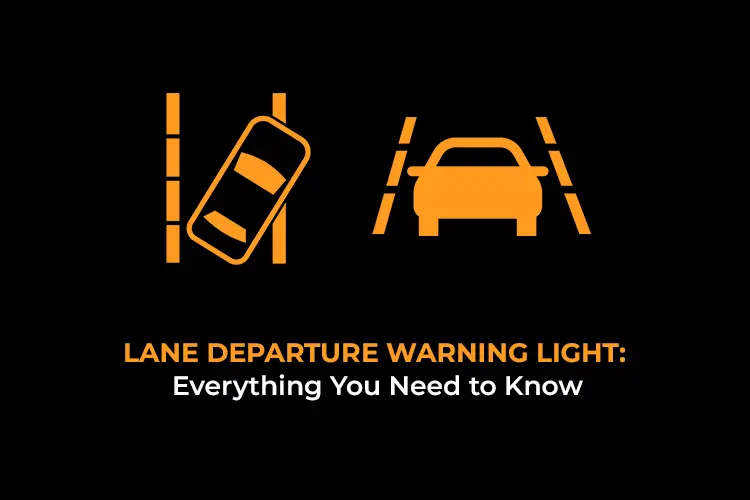
Lane Departure Warning Light: Everything You Need to Know
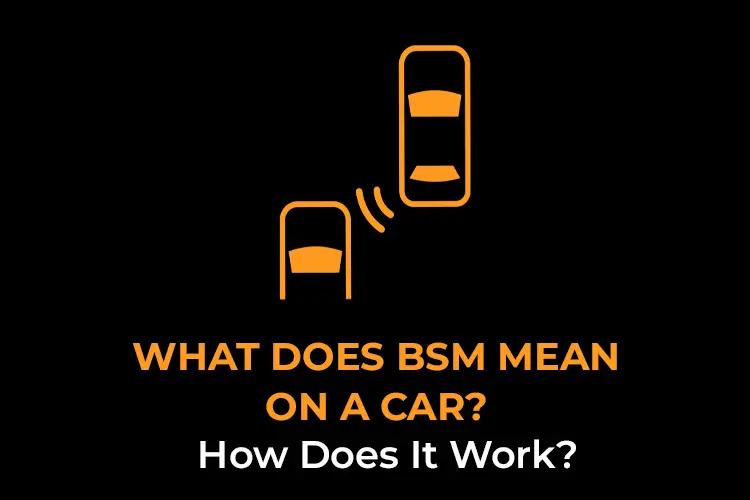
What Does BSM Mean on a Car? How Does It Work?
Leave a comment cancel reply.
Your email address will not be published. Required fields are marked *
Save my name, email, and website in this browser for the next time I comment.
Recommended for you
Abs light on the toyota camry: 5 causes and how to fix it, bmw emergency call malfunction: 5 causes and how to reset, adaptive headlight malfunctions on bmw: here is how to fix, start typing and press enter to search.
Truck of Mine
reliving the truck passion

Ford Cruise Control Troubleshooting & How-to Guide
Ford’s adaptive cruise control is a game-changer when it comes to safe driving. Not only does it help to maintain the approved safe distance from other cars, but it also helps you control your speed when on busy roads or the highways. This gives you a better driving experience overall and decreases your chances of getting into an accident.
How to activate cruise control on a Ford
- Press the ON/OFF button on the steering wheel.
- Then cruise to the speed you wish to be at and Press SET.
- Take your foot off the accelerator and press the car icon on the steering wheel to set the minimum desired gap.
Note: There are four different gap options from close to further away. The more lines on the screen, the further the distance.
- When the cruise control is active, green light with a clock, car, and arrow will appear on the dash.
How to use Ford cruise control with a start and stop
The adaptive cruise control makes driving easier because it eliminates the need to readjust cruise control speed constantly. It uses an intuitive system that automatically adjusts speed to maintain a set distance from slower-moving vehicles ahead. When traffic speed increases, the cruise control system resumes the designated speed.
Press the up and down arrows on your steering wheel cruise control switch to set a gap distance. Use the short, solid arrow above to decrease the following distance. Use the longer arrow below to increase the following distance.
You can cancel at any time by hitting the brake or pressing the cancel button on the steering wheel. They will then return the vehicle to its previously set speed and gap settings when pressing the Resume button.
Note: There are four gap distance settings. One bar indicates the shortest following distance available, while four bars indicates the longest distance.
How to Switch between Normal and Adaptive Cruise Control
- Use the arrow pad on your steering wheel to select “Driver Assist” on your vehicle’s information display.
- Select Cruise Control> Adaptive to enable Adaptive Cruise Control.
- Select Cruise Control> Normal to return to conventional cruise control.
How to deactivate Ford cruise control
Press the brake pedal or cancel on the steering wheel. Refer to the manual to locate the cruise control ON/OFF button.
What Ford models have adaptive cruise control?
Not all Ford vehicles come equipped with the Adaptive Cruise Control features. Additionally, the feature may have varying capabilities on different car models. Below is a list of Ford car models the have the cruise control either as a standard feature or an optional feature;
- Transit Connect
- F-150 Raptor
- F-250, F-350, F-450
How to safely test Ford cruise control
Press the cruise OFF button and hold it down. Then cycle the ignition key from RUN to OFF to RUN quickly without starting the engine. The cruise control indicator light will flash once to indicate that you have successfully entered the test mode.
Ford cruise control troubleshooting
The cruise control module can malfunction from time to time. When this happens, you should determine the issue before trying to fix it. This will enable you to figure out if the problem is as simple or a fuse or a vacuum leak.
Follow these steps to troubleshoot the cruise control;
Start by opening the fuse panel under the steering wheel. Pull up on the fuse panel release lever and then pull the fuse panel down.
Then check the brake lights and cruise control fuses. You can refer to the diagram on the fuse panel cover to locate these fuses. The cruise control system will not work if the cruise control module fuse is burnt or damaged. And the brake lights won’t work if the brake’s fuse is damaged.
Start the vehicle and monitor the vacuum lines on the intake and brake booster to check for a vacuum leak. This air leak will cause the cruise control system to malfunction as the cruise control will not control the vehicle speed efficiently. Also, check for a rough idle and a “sucking” sound coming from the engine bay while running. This is also an indication of a vacuum leak.
Then check to see if the throttle cable is damaged or frayed as this may also prevent the cruise control from working efficiently when controlling the throttle.
Finally, shut off the vehicle and disconnect the negative battery cable. Then loosen the retaining nut on the negative battery cable and slide the cable off the cable clamp. Remove the steering wheel column cover in place and pull the cover off the steering column with your fingers.
Unplug the electrical plug from the cruise control switch. And remove the screws holding the cruise control stalk to the steering column. Inspect the cruise control module and combination stalk. You use a working stalk to determine if the cruise control module or existing stalk is damaged.
Symptoms of a bad cruise control switch
This is the switch that controls various functions of the cruise control system. The switch is mounted on the steering wheel, and it houses all the other cruise control’s controls. When this switch is damaged, it may prevent the proper functioning of the cruise control. Here are the signs of a failing cruise control switch.
The cruise control light doesn’t illuminate
The light should light up immediately after activating the system to let the driver know that the cruise control system has been activated. If the light does not turn on, then the LED indicator controller may be damaged.
The vehicle cannot maintain set speed or acceleration
Irregular speed acceleration is a sign of a failing cruise control switch. The system is designed to control the vehicles speed at a predetermined speed. Lack of speed maintenance or speed acceleration beyond the set speed is a sign of a damaged cruise control switch.
Note: if your cruise control switch is damaged, have a trained professional fix or replace it. Running a self-diagnostic and fixing the switch may void the warranty. You may also end up damaging other components of the cruise control system.
Check this too: Popular 2017 Ford Escape Problems To Look Out For
Ford adaptive cruise control problems and their fixes
Here are some common cruise control issues and the most probable fixes when your vehicle is experiencing cruise control problems.
Issue: Your truck’s cruise control isn’t working at all
- Check the fuse, horn relay fuse, and cigarette lighter fuse to ensure they are not damaged.
- Inspect the throttle actuator cable to see if it is broken or disconnected from the throttle.
- Check the brake light bulbs to ensure they are not burnt out.
Issue: The cruise control won’t disengage when the pedal is pushed
Fix: Check the brake light switch, fuse, and wiring.
Issue: Some switches work, and some don’t
Fix: Check the switches. They are the most likely culprit and need to be replaced.
Issue: The cruise control system loses speed up long or steep hills
- Turn off overdrive when going on up steep hills. It may help.
- Check the vacuum check valve in the Servo feed line if your truck loses speed on smaller hills.
- Check the vacuum reservoir tank for leaks.
Reasons Why the Cruise Control is Not Working
If your cruise control is not working, you can look at several items to verify the problem. This, in turn, makes it easy to repair. Below are the main reasons why your cruise control is not working;
Brake Light Switch – The cruise control system is automatically cancelled by depressing the brake. Some Ford vehicles can disengage cruise control if the brake light switch cannot be detected.
Brake Lights – The cruise control is designed to become disabled when the brake light is blown.
Fuses and Relays – A blown fuse or damaged relay will affect the cruise control.
Spiral Cable –A faulty spiral cable will prevent the switch from contacting the CCM.
Control Switch – If the internal contacts wear out, the cruise control switch may not contact the CCM. This might disable cruise control altogether, or it might not react to the cancel or accelerate functions.
Check Engine Light – This is an indicator of a failing engine or fuel pump, which may, in turn, affect acceleration while cruising.
Vacuum Leak – A vacuum leak may affect the vehicle’s ability to control the throttle body during cruise control operation. If there is a leak due to a cracked hose or tube, the cruise control system will not work.
Vehicle Speed Sensor – Ford vehicles are fitted with multiple vehicle speed sensors (VSS). The CCM might use a VSS feed from the ECM, instrument cluster, or transmission. If a speed sensor is damaged, the CCM can’t detect vehicle speed, thereby disabling the cruise control system.
Electrical Problems – Check for continuity to ensure power is remitted as it should.
Note: do not under any circumstance if it is faulty. If the cruise control system is defective, it may not cancel on demand, which will create a safety hazard for you or others on the road. Additionally, hire a trusted mechanic to carry out the diagnosis and repair of the cruise control system.
How do I know if my cruise control module is bad?
The most common sign is the inability to use it to activate cruise control. It may also fail to perform various adaptive cruise control functionalities such as distance and speed maintenance. The failure to deactivate cruise control is also a sign of a failing cruise control module.
Is it expensive to fix cruise control?
On average, it will cost you between $150 and $350 to repair the adaptive cruise control. This depends on the parts needed and the labour costs. The car model also affects the sot of the components required to fix your cruise control. The price may also vary depending on your location. Anticipate a higher price markup if you live in a big city.
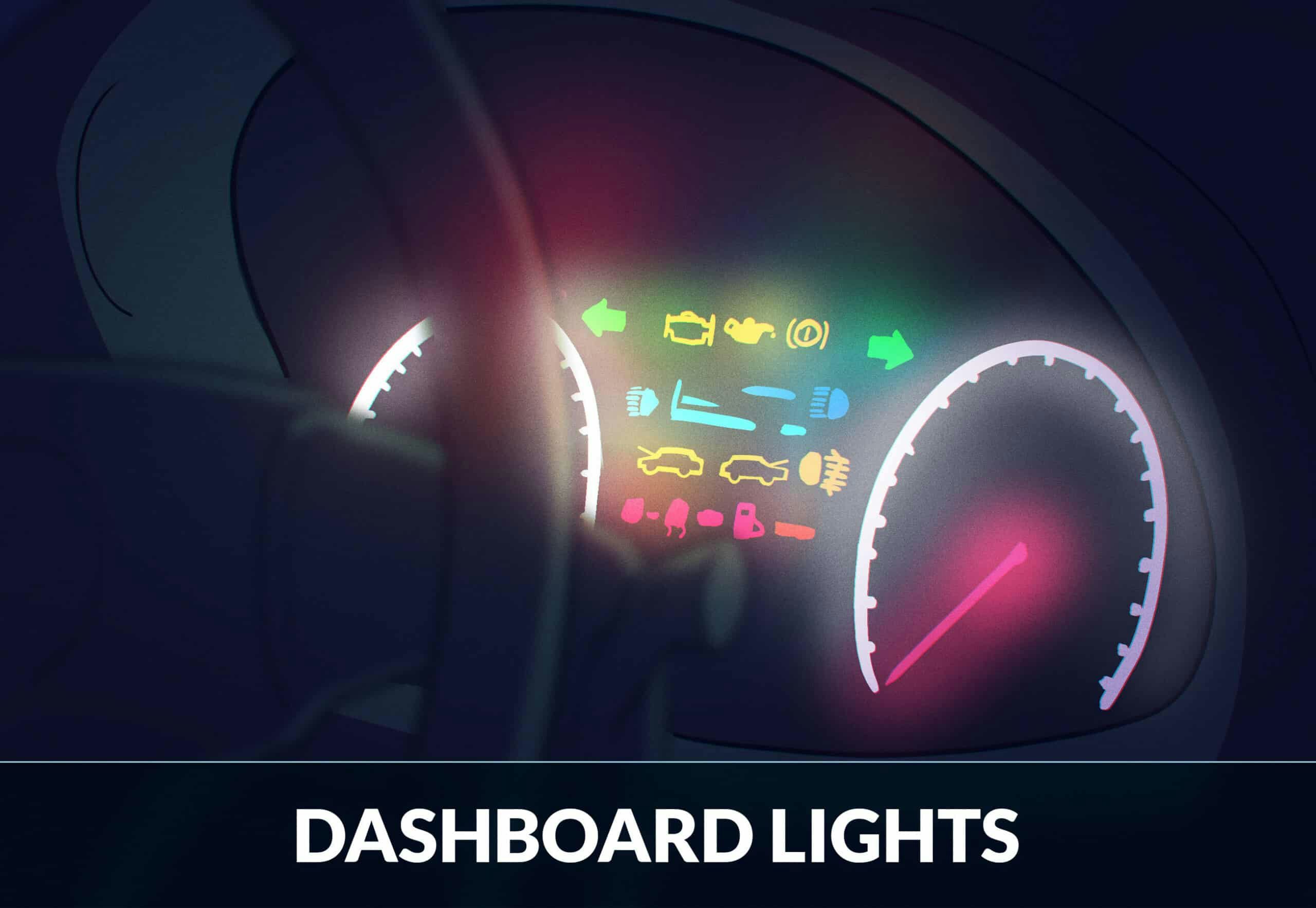
Dashboard Lights Explained: Meaning of Different Symbols & Indicators
Whether you have a brand-new car or a tried-and-true used vehicle, every once in a while you’ll see one of your dashboard symbols light up while you’re driving. Although you may know what a few of the symbols mean, it’s likely that some of those warning lights may be mysterious and concerning. In some cases, dashboard lights may just be reminding you to schedule service or check some system in your car before something more serious occurs. In other cases, they serve as an important warning to act as soon as possible.
Today, we will go through the most common and important dashboard warning lights, what they mean, and which ones will require you to take action. You’ll also find complete lists of all lights at the end of the article.
The Most Common Warning Symbols on Your Car’s Dashboard
The following dozen dashboard warning lights are some of the most commonly seen by drivers, and it’s particularly important that you understand what they are telling you.
In some cases, they may just be reminding you to schedule service or check some system in your car before something more serious occurs. In other cases, they serve as an important warning to act as soon as possible.
Fuel Warning Light

This is a well-known one – the low fuel warning light. Usually, this light comes on when your fuel tank is dangerously near empty. Although some drivers ignore the low fuel warning for dozens of miles, it’s more prudent to start looking for a gas station as soon as this light is triggered. Remember, stopping for gas before you hit empty will save you a lot of stress and time should you run out of fuel on the road.
Oil Indicator Light

Besides gasoline, having the right level of oil in your car may be the next most important fluid to keep things running smoothly. Good quality and proper quantity of oil serve to keep your engine lubricated well and functioning at its peak. If your oil warning light goes on, this may indicate one of several things. It may be time to schedule a regular oil change or be prompting you to add oil to your vehicle. This dashboard light may also be triggered if you need to repair an oil pump that has malfunctioned and is no longer circulating enough oil throughout your vehicle. Regardless of the issue, this problem should be addressed as soon as possible.
Tire Pressure Light

When your parents were young, it’s likely that their families used an old-fashioned tire pressure gauge to periodically check that car tires were inflated properly. However, these days, most vehicles can monitor this automatically. If your tire pressure warning light is on, it means that one or more of your tires may require more air. Although this is often not an emergency, be sure to check and refill your tires as soon as possible. It may indicate a slow leak caused by a nail lodged in your tire or serve as a warning that you may be dealing with a flat tire in the near future. If you drive with incorrect tire pressure for a long period of time, it can cause additional problems in your car as well as result in poor gas mileage.
Check Engine Light

The “check engine” warning light may be hard to interpret, this is due to the fact that a wide variety of issues may trigger this warning. On one hand, it may require a simple fix such as tightening your gas cap. If your gas cap Is loose, fuel may evaporate and trigger your engine light.
On the other hand, the warning light could indicate a serious problem that requires immediate attention. When your check engine light appears, be sure to have a mechanic evaluate the problem as soon as possible. Many auto supply stores can help you diagnose the light at no charge.
Battery Warning Light

Although this dashboard symbol is symbolized by a battery, problems that trigger this warning may have to do with a car’s overall electrical system in addition to battery issues. When this light appears, pay close attention to the electrical systems in your vehicle. For example, if your headlights seem dim, you may require a new battery. Other electrical systems and alternator problems may require a professional to diagnose and repair.
Seat Belt Indicator Light

The seatbelt warning light may be one of the most important in your car. If the driver or the front seat passenger is not buckled up safely, this light will often be triggered along with a warning beep or signal.
In most states, wearing a seatbelt is required by law. Be sure that all your passengers stay buckled anytime your vehicle is moving. The use of seat belts significantly reduces injury and death in car-related accidents.
Temperature Warning Light

Although your vehicle probably has a temperature gauge that ranges from cold to hot, it’s unlikely that you check it frequently. Vehicle manufacturers realize this and, therefore, have included a temperature warning light.
When this light is triggered, it means that your engine is overheating, which can be a dangerous situation. Most likely this is caused by a low coolant level or some other problem with the cooling system in your car. Be sure to have a professional mechanic explore the reason for this problem as soon as possible.
Brake Warning Light

The brake warning light can have multiple meanings, which can be confusing for drivers. It will be on if you have engaged your parking brake, for example, and is simply reminding you to disengage it before driving.
However, if your parking brake is not on and your brake light still is, this may indicate a problem with your brake pads, discs, or calipers. It can also be triggered when your brake fuel is low or your ABS system is not working. The inability to stop a car is a dangerous situation, so if your brake light is on, be sure to find the cause immediately.
Cruise Control Indicator Light

Usually, the cruise control light is not a warning light like many of the others on this list. Instead, it simply reminds you that your cruise control feature is engaged and that you can simply set your car to maintain a constant speed. However, in some cases, if the light isn’t green, it can indicate a problem with the system.
Traction Control Light

Driving during inclement weather conditions can be hazardous. Fortunately, many car manufacturers have added features to help make winter and rainy driving a little safer. The traction control indicator symbol signifies that a car’s traction control system is on. Working with an anti-lock brake system (ABS), the traction control can detect when one wheel is spinning faster and slipping. At this time, the system triggers the braking system until the car regains traction.
Anti-lock Brake Light

ABS stands for anti-lock brakes, and when this warning light appears, it indicates a problem with the car’s ABS system. Although your regular brakes will continue working even without your ABS, it’s important to get this problem examined by a professional at your earliest convenience. This is especially important if you’ll be driving in wet, icy, or snowy conditions when an ABS system provides an extra layer of safety support to keep your tires in contact with the road.
All Warning Symbols

All Red Safety Symbols
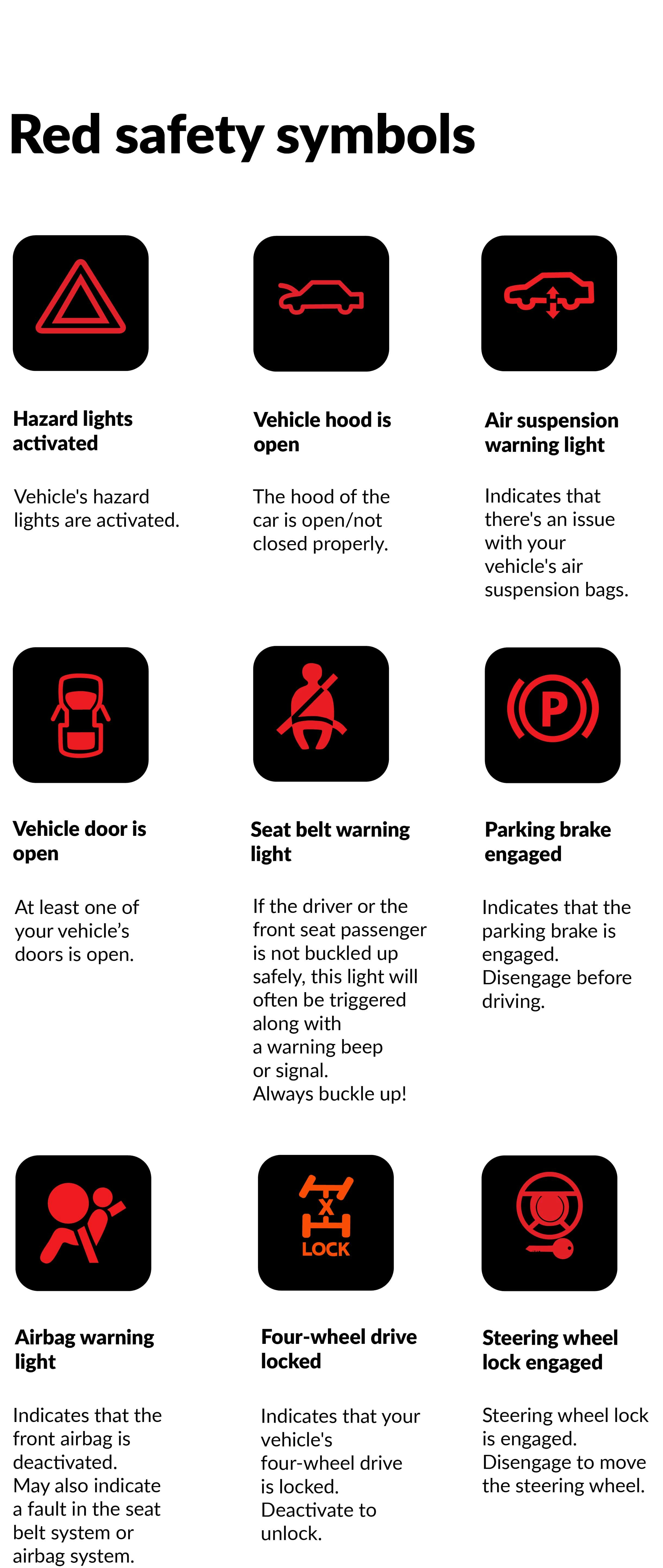
The warning lights on your car’s dashboard are designed to help you drive safely and reduce emergency problems on the road. Be sure you pay attention to them when they appear. If you’re not certain of their meaning, consult your driver’s manual for more details.

550+ exam-like questions
All you need to ace your test
Perfect for first-timers, renewals and senior citizens
Recommended articles
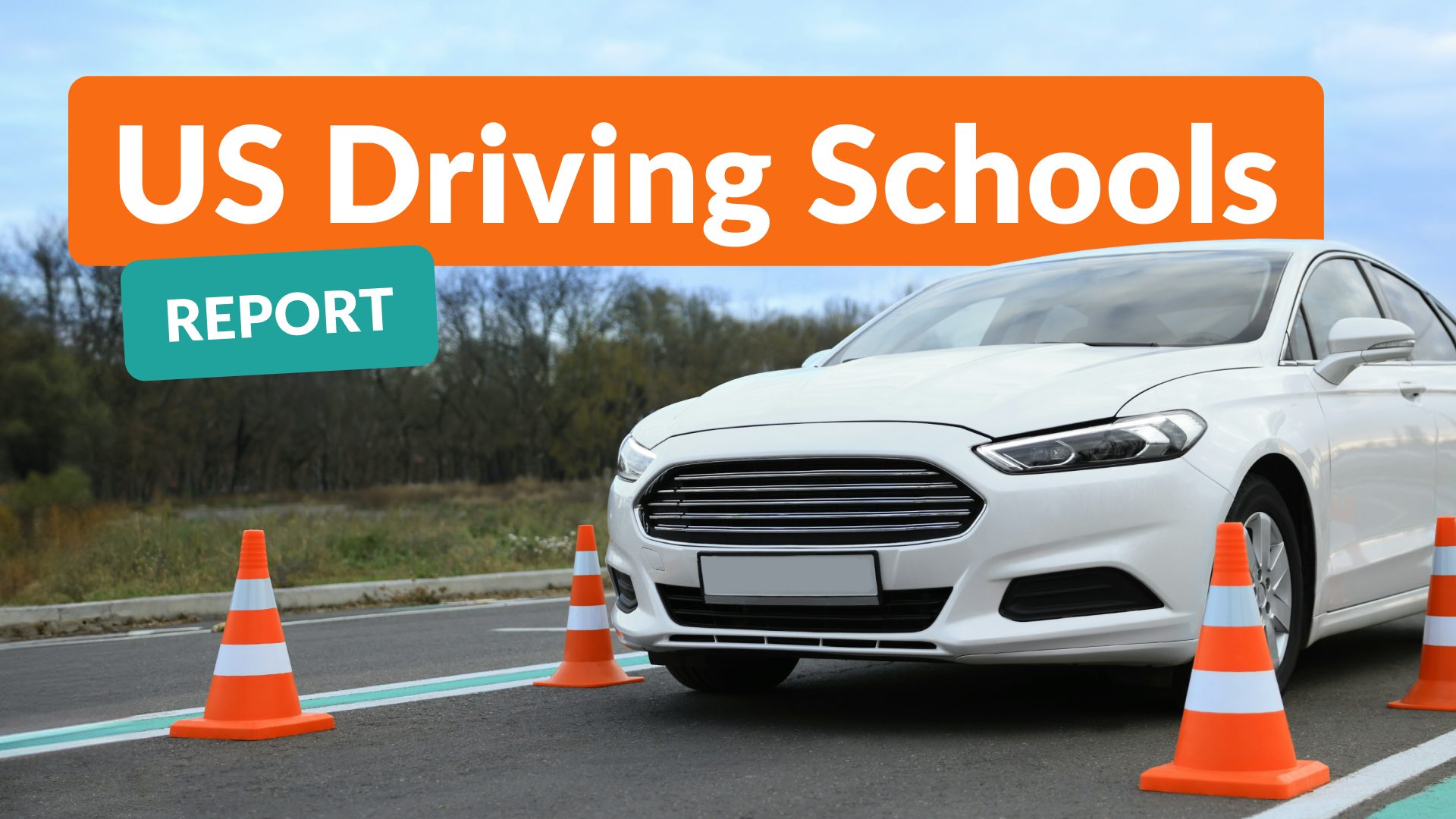
Driving School Costs Report – The Cheapest and Most Expensive States
For many, the ability to drive is not just about mobility—it’s a rite of passage that symbolizes freedom and the thrill of charting one’s own course. the anticipation of sitting behind the wheel for the first time is a universal dream, yet for many aspiring drivers in the united states, this dream comes with variable […].
Distracted Driving Report – The States With the Least and Most Distracted Driving
In april 2024, the national highway traffic safety administration (nhtsa) released data for 2022 that illustrated traffic deaths due to distracted driving increased by 12 percent from 2020 but decreased compared to 2021 to 6%. every year, thousands of drivers and passengers are fatally injured as a result of distracted driving. in 2022, roughly 2,109 […].

Traffic Safety is Crucial to Your Business
By kristin pettway, drive smart virginia april is distracted driving awareness month and the perfect opportunity for workplaces to review their traffic safety policies and communications. traffic crashes are the leading cause of workplace deaths in america. even if you don’t have a fleet of vehicles, safe driving should still matter to your business. after […].
Ace your DMV test, guaranteed
Get started
Best of the Zutobi blog
- Learner’s Permit Ultimate Guide
- Driving Test Ultimate Guide
- Traffic Lights Guide
- How to Pass the DMV Permit Test
- How to Pass the Driving Test
- Common Reasons For Failing the Road Test
- International Driver’s Permit Guide
- Driver’s License Renewal
- How to Get Your US Driver’s License
- How to Prepare for Your Road Test
- How to Get a Driver’s Permit
- Behind-The-Wheel training
- Terms & conditions
- Privacy policy
- Do Not Sell My Personal Information
- Subscription terms
- Terms & policies
Practice Tests
- Car Practice Tests
- CDL Practice Tests
- Motorcycle Practice Tests
- Sign In by Email
- Sign In by Phone
By continuing to use the application, you agree to privacy policy
- Dashboard Warning Lights Explained
Dashboard Warning Lights Explained | AutoCatalystMarket USA

Indication types
Red warning lights, yellow warning lights, blue and green warning lights, actuation lights, front and rear fog lights indicator, headlamp indicator, main beam indicator, cruise control indicator, directional indicator, shift indicator, warning lights, brake system warning light, engine coolant temperature warning light, transmission warning light, battery warning light, engine oil warning light (oil pressure), low fuel level warning light, glow plug indicator, safety indicators, anti-lock braking system warning light, reduced power warning light, tires warning light, stability control indicator (traction control), catalytic converter warning, safety belt indicator, door ajar warning light, front airbag warning light, frost warning light.
Modern automobiles heavily depend on electronic systems, which hinge on sensors connected to the array of alert symbols adorning the dashboard. These sensors diligently observe your vehicle's performance. In the event of a malfunction, your initial notification typically arrives via a dashboard warning light. The multitude of distinctive cautionary lights and indicators might initially overwhelm you. Overlooking crucial warning signals carries the potential of jeopardizing your safety or incurring substantial expenses for vehicle repairs. While there exist dashboard lights common to all automobiles, some cater specifically to the make and model of your car. While most of these car indicators exhibit a uniformity, we will delve into their particulars today. However, if you happen to possess a unique configuration, it's wise to consult your owner's manual for verification. Diverse categories of indications will be explored.

When you start a car, you will see some warning lights come on. But do not worry, this is normal because it is just a routine check to show that they are all functioning. If there are warning lights stay on after five seconds of starting the car, then there is a problem.
There are 3 types of warning lights each represented by color.
- Red warning lights
- Orange lights
- Blue and Green operational indicators
Generally, red lights mean there is a severe problem and you should act quickly to resolve it. If it is critical, then it might also flash, then stop your car as soon as it is safe to. Once you have stopped in a safe place, it is time to check your car manually to find out if it is safe to carry on driving.
Typically, amber or yellow dashboard lights serve as signals that immediate attention or maintenance is needed. These lights indicate that the engine's computerized management system has identified a malfunction. While it's feasible to continue driving your vehicle with an illuminated orange warning light, it's strongly recommended to promptly schedule a visit to your nearby service center for a thorough diagnosis and necessary repairs.
If the lights are in green or blue it tells you the system is on and it is operating, so it basically confirms the activation such as your main beam headlights.
These are usually Blue and Green lights that indicate that something is running on such as car head and tail lights.
When either the front or rear fog lights are in operation, this light will become illuminated.

This light becomes illuminated when you activate the dipped beam headlights or engage the side and tail lights.

Upon activating the main beam headlights, a blue dashboard light will make its appearance. This blue light will blink when you employ the headlight flasher.

This will be illuminated when you have cruise control on.

Here are your indicators for signaling left or right turns, or to activate hazard warning lights. They flash when turned on. If the indicators stay on or flash faster than normal then check for a burnt-out bulb.

This informs you that changing to a higher or lower gear may give better performance, and help you reduce fuel consumption and CO2 emissions. It will not come on during periods of high acceleration, braking, or if the clutch is pressed down.
Mostly engine-related indications that warn about severe malfunction or lackluster and many other safety sensors.

When your vehicle remains stationary with the ignition or engine running, an indicator light will illuminate, signifying that the parking brake is presently engaged. However, if you happen to spot this light while in motion, take a moment to ensure that the parking brake has been fully disengaged. If that's not the issue, it's a red flag indicating either insufficient brake fluid or a malfunction within the braking system. It's possible that hydraulic pressure has dissipated on one side of the brake system, or there may be a perilously low fluid level in the master cylinder due to a potential brake system leak. Should this brake warning light unexpectedly make its appearance in the midst of traffic or while driving, there's no need for alarm. Most vehicles are equipped with multiple hydraulic braking systems, and though it might necessitate slightly more time to come to a complete halt, you can securely maneuver to the side of the road. From there, arrange for your vehicle to be towed either to your residence or to a reliable mechanic for a thorough examination.

The warning light associated with engine temperature, also referred to as engine coolant temperature, indicates that your engine is operating at an excessively high temperature, or in simpler terms, it's overheating. Ideally, under proper functioning conditions of your vehicle's cooling system, such a situation should never arise. Nevertheless, a malfunction in the cooling system or insufficient coolant levels can trigger engine overheating, ultimately resulting in damage to the engine. Driving your vehicle while it's in an overheated state can lead to severe, sometimes irreversible, harm to your engine. Therefore, when the temperature warning light makes its appearance, it's advisable to promptly pull over to the roadside when it's safe to do so, turn off your engine, and allow it to cool down. There are some common reasons for that to happen. If the car has too little or no coolant, leakage in the cooling system, a broken water pump, radiator issues or engine oil is too low. Always check your coolant level before driving and store an extra bottle of new antifreeze and a gallon of water in your trunk. Do not overuse the car’s air conditioning on extremely hot days.
Do not mess Engine temperature symbol with a one similar that has a gears icon around it. This symbol means that your transmission overheats. The ideal temperature here is 175 degrees, overheating occurs after it surpasses 200 degrees and the failure rate doubles for every additional 20-degree increase. Depending on the severity of the problem the indicator appears from yellow to red.
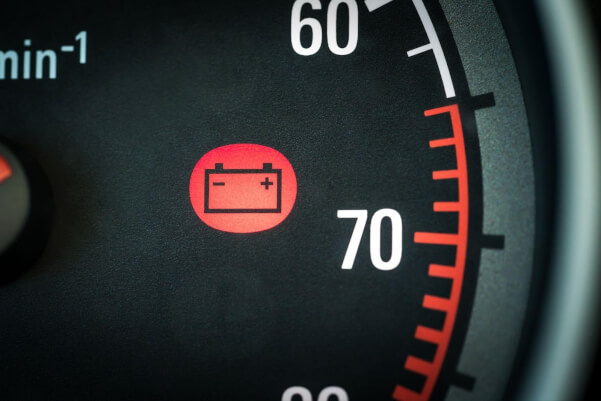
This light serves as an indicator of an inadequately charged or malfunctioning car's power supply system. Typically, it signifies an issue either with the battery itself or the alternator. Upon starting the vehicle, the charging system warning light is expected to briefly appear, but its persistence during your journey can indicate an underlying problem. Several factors could contribute to its illumination, including a faulty or depleted battery, issues with the charging function of the alternator, wiring complications, and more. While it's technically feasible to continue driving with this warning light activated, it's not advisable. An alternator malfunction can lead to a depletion of power in the battery, potentially resulting in a complete power loss. Therefore, it's wiser to conserve power by minimizing unnecessary electrical consumption and promptly arrange for a professional inspection.
Possible fix is to clean any rust of the contacts and then tighten any loose battery cables, if that doesn’t help then you still need to lead to service to check the alternator and wiring.

The presence of this light signifies a drop in oil pressure, indicating a shortage or even a complete absence of lubrication. It's imperative to pull over your vehicle promptly and with utmost care. After doing so, consult the service manual for guidance and employ a dipstick to assess the oil level. Take off and wipe any oil of the dipstick first to refresh then insert it into its tube and then push it back in to see the refreshed oil level and if it needs to be topped off. If the level is correct, it can also be caused by a faulty oil pump, clogged oil filter, or an internal oil leak. It can also be a false alarm caused by a bad oil pressure sensor or its wiring.

This light warns you that you have low fuel and to refuel as soon as possible.

This is designed for diesel vehicles specifically to preheat the cylinders before you turn the engine over to start it. If this light is on wait until it goes off before starting the car. If it is flashing while you are driving that indicates a fault in the system.

The ABS system warning light serves as a cautionary signal for the driver, indicating a potential issue with the Anti-Lock braking system. In particular, dedicated sensors keep a watchful eye on wheel speeds. If any of these wheel speed sensors fail to operate or exhibit defects, the ABS warning light will persist in its illuminated state. The same applies if there's an issue with the wiring. The symbol will look like the letters ABS surrounded by two circles with the top and bottom of the outer circle cut off.
ABS, in the event of sudden, forceful brake pedal application during emergencies or on slippery terrain, safeguards against wheel lock-up. Your standard braking system remains operational unless the brake system warning light is concurrently lit. In such a scenario, it's advisable to seek a prompt inspection.

If this is on when the engine is running then there is a malfunction. Your car will continue to run but it has limited power. This measure is needed to prevent permanent engine damage from occurring. The computer in your car, also known as ECU, has triggered the reduced power mode after it has detected a system failure. One of the most common triggers is a problem with the electronic throttle actuator control system. Some cars may light this message because of a faulty electronic fan clutch but some other cars may show this light due to a problem with a fuel system. If it flashes when you are driving then slow down as soon as it is safe to. If it continues to flash then avoid heavy acceleration or deceleration. Try to restart the engine and see if the indicators are off or appear blinking again. If the issue persists, check your car immediately.

The glowing indicator serves as a warning that one of your tires is experiencing reduced pressure, dipping below the 25% threshold. When this light illuminates, it suggests a potential issue with under-inflated tires. Nonetheless, it's advisable to employ a gauge for a precise assessment of the root cause behind the pressure drop.

This flashes when the stability control is operating. If this light stays on continuously while driving then there is a malfunction. It has 2nd state in case you switched the stability control off manually, it adds the OFF sign beneath.

The illuminated indicator signifies the deactivation of your vehicle's traction control. This mechanism's purpose is to facilitate a more gradual and controlled acceleration for your car. It operates by means of a computer that discerns if one or multiple wheels have started to slide and lose their grip on the road surface. Traction loss is frequently encountered in snowy weather, where a spinning wheel encounters an icy patch, leading to slippage. In response to such situations, the traction control system redistributes power from the slipping wheel to those that maintain traction, ensuring steadier and safer movement.

An indicator light that means the cat converter is either overheating or not operating as intended. This is caused by the metal can start deteriorating over time and plug up the honeycomb cells inside the device leading to overheating issues caused by restricted airflow.

If you neglect to fasten your seatbelt, you'll notice the emergence of a visual indicator, accompanied by an auditory reminder. In the contemporary automotive landscape, all vehicles feature seatbelt sensors as a vital safety measure. These sensors are responsible for evaluating the status of your seatbelt – whether it's securely fastened or left unbuckled. This information is crucial for the passenger safety system, especially in determining the most appropriate deployment of airbags. Furthermore, the system springs into action if it detects an unbuckled seatbelt while the car is in motion, traveling at speeds exceeding 15 miles per hour. If, upon fastening your seatbelt, it continues to flash, it's indicative of a malfunction in the seatbelt sensor or possible damage to the buckle housing. In such cases, replacement becomes necessary.

You will see this light if the bonnet, boot, or any door has not been closed properly.

If this does not go off or flashes once you have started your car, then get it checked.

You will see this light when the outside temperature is 4 degrees or below to inform the driver that ice may start forming. As the temperature goes below the freezing point it turns red to warn you about increased chances to meet the ice on the road.
Since 2005, he has been engaged in the business of recycling and processing automotive catalytic converters. Thanks to many years of experience, he has become an expert in the assessment and classification of automotive catalytic converters, which formed the basis for the creation of the website autocatalystmarket.com .
- rh $144.695
Related articles

Popular catalytic converters

Car Insurance
Home & renters insurance, car repair estimates, read car content, jerry data & research, what does the cruise control warning light mean.
A certain warning light has been on in my car: it’s the same exact light that turns on when I use cruise control, only it’s orange instead of green. Weirdly, it still turns green when I set my cruise speed, and it seems to work fine. What does the cruise control warning light actually mean?

- Faulty brake switch
- Malfunctioning speed sensor


Join 4M+ members in lowering their car insurance
You might also be interested.
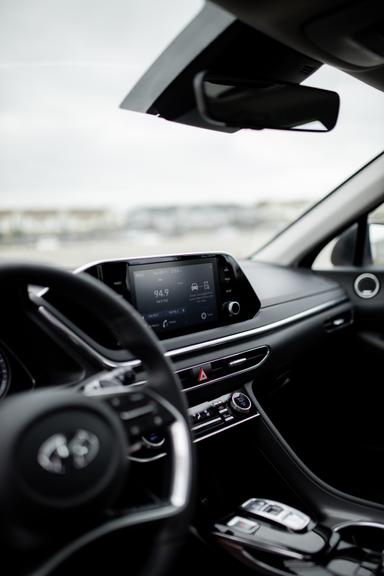
What Does the 2016 Hyundai Sonata Traction Control Light Mean?

What Does the Chevrolet Malibu Traction Control Light and Check Engine Light Mean?
.jpg&w=64&q=75)
What Does Your Check Engine Warning Light Mean?

Read Advice From Car Experts At Jerry

Adulting then and now: How growing up has changed

How to Donate a Car in Kansas

2022 BMW X7 Specs

What Others Are Asking
Is an expired sticker a moving violation in massachusetts.

How do I fix a small dent in my car hood?

How far is the drive from Fort Lauderdale to Miami?

Browse More Content
Car repair resources.
- Strut Assembly Replacement Cost
- Turn Signal Switch Replacement Cost
- AC Air Filter Replacement Cost
- Reverse Light Bulb Replacement Cost
- Cabin Air Filter Replacement Cost
Insurance for Your Car
- Chevrolet Cavalier Insurance Cost
- Acura Ilx Insurance Cost
- Mazda 5 Insurance Cost
- Mitsubishi Endeavor Insurance Cost
Insurance in Your State
Insurance in your city.
- Cary NC Insurance
- Renton WA Insurance
- Fulshear TX Insurance
- Warrensburg MO Insurance
- Shrewsbury MA Insurance
Easiest way to compare and buy car insurance
Car insurance by make, car insurance by model, car insurance by state, car insurance by city, car loan by make, car insurance by company, car loan by state, car repair by service.

- WordPress.org
- Documentation
- Learn WordPress

What is the cruise main indicator light on the dashboard?
The cruise control feature is a great addition to a car’s configuration- driving is made more fun. The feature allows you to maintain speed without having your foot on the pedal all through.
This feature is convenient and serves a notable need but it can also be dangerous. To make it safer, automobile makers added the Cruise Main Light- it serves to keep you safe from the many occurrences that make the cruise control unsafe.
What Is A Cruise Control Main Indicator On The Dashboard?
When you activate or the cruise control is activated , the car informs you by illuminating the cruise main indicator. Note that it signifies activation but not setting- you will still need to set the speed to get the feature to full functionality.
After setting the speed, you can release the accelerator pedal and lean back. This feature offers long-distance drivers an opportunity to rest their feet without having to pull over.
The cruise’s main indicator is more of a safety light than a comfort feature. It was implemented after car makers realized that cars activated the cruise control feature without notifying the drivers causing the driver to panic when they relax the gas pedal but the car does not reduce speed.
The light came with one power button that allows the driver to turn the cruise control ON although they still need to set the speed. Before this, some drivers came to learn about activated cruise control when it was too late.- some occurrences were catastrophic.
The fact that the light only indicates the feature’s activation without necessarily setting the speed makes it much safer.
What Does It Mean When The Cruise Main Light Comes On?
When you spot this light, it means your cruise control has been activated. If you did it yourself then that’s ok but if you didn’t activate it, you ought to pull over and get some answers .
After activation, the next step is usually to set the cruising speed and let the car do its thing. With the cruise control fully engaged, you can lift your foot off the gas pedal and rest a little bit.
What Causes The Cruise Main Light To Come ON?
If you didn’t activate the cruise control several occurrences could make the cruise main light come ON.
The most obvious possibility is that the light didn’t go off the last time you put it OFF. This happens when the main button gets stuck or malfunctions. If this is the case, the cruise main light will stay ON throughout or go OFF from time to time without the driver’s input.
Another possibility is an underlying issue in the cruise control system. The system could be sending false triggers to the car’s computer.
This causes it to illuminate the cruise main light even when the feature is turned OFF. For an issue like this, the culprits are many but you can start with the wiring and sensors.
Are There Any Problems With The Cruise Main Indicator Light?
The cruise main light is affected by a myriad of problems like blown fuses, failed speed sensors, and dead brake switches. These problems are mild and should be easy to repair- there’s nothing to stress about.
How Do I Turn Off My Cruise Main Light?
The cruise main light is built to work hand in hand with the cruise control feature. If you turn the cruise control OFF, the light should go OFF too.
There are two ways to deactivate the cruise control feature, you can: step on the brakes or simply use the ON/OFF button.
If you for some reason turn it OFF by mistake, you can get the car back to set speed using the RES button although you’ll need to first accelerate it to 25 mph or more.
The cruise control feature is praised and criticized all over the globe. Its supporters say the feature allows drivers some relaxation time while its critics claim laxity can easily lead to accidents.
To keep the feature safe, it comes with a cruise main light that notifies you when the system comes ON so nothing gets you by surprise.
The light is pretty friendly and can be turned OFF by the press of a button although you’ll turn the cruise control OFF too.
About The Author
Start typing and press enter to search

CarParts.com will be back soon!
We apologize for the inconvenience. The CP Team is working on some upgrades to improve our service. Thank you for using CarParts.com!
You can call us at
1-866-529-0412
Reference ID: 18.7fc733e.1714681701.27dd91a1

- Forum Listing
- Marketplace
- Advanced Search
- Toyota Passenger and Sports Car Forums
- Corolla and Matrix Forum
- Corolla 12th Gen (Hatch 2019+/Sedan 2020+)
Cruise control indicator
- Add to quote
It should be on the right side of the steering wheel with the same symbol for the cruise control.
rschwabe said: I can’t find a way to do that Click to expand...
Hi. Thanks. I tried pressing every button. Nothing turns the indicator light off. Searching around I found another thread from someone saying their Rav 4 has the same condition(the light always being on). I guess the light turns green when actually using cruise control. So maybe the light being always on and white is normal. Seems weird to me.
rschwabe said: So maybe the light being always on and white is normal Click to expand...
Maybe you have to keep button "B" depressed for a longer than a quick depress? On my previous company car 2021 R4P, Cruise Control would come on WHITE, when "activated", and GREEN when engaged. If the turned Cruise Control OFF, no lights.
“B” button can be toggled on and off. You can leave it the way it is and just set the speed when you want to use it. The only question is, does it turn off with the ignition. On some cars I’ve rented, the cc has to be turned on each time the engine is started. It doesn’t default to always on.
Thanks for everyone’s replies. Looking into this further I found a couple of videos on YouTube that were posted about Toyota cruise control. I think one of the videos was from a dealership. Looks like starting in 2023 with Toyota Safety 3.0 , the cruise control indicator light is always on when the car is on. You can press the driver assist mode select switch (button A)to select which cruise control system you desire and then I believe if you press the driver assist switch(button B), that actually activates the cruise control and allows you to set the speed. I still find it strange that the light is always on but it is what it is. The cruise control system on our 2010 Corolla was a lot simpler to operate.
rschwabe said: ... The cruise control system on our 2010 Corolla was a lot simpler to operate. Click to expand...
it is weird Toyota did that. so does the light turn green when you activate cruise? i prefer not seeing a light for a feature thats not activated
They seem to have taken a page out of the German's playbook; cruise control is always "on" so anytime you want to use it you only have to press set. No need to turn it on then press set. Honda had something similar, their cruise on/off button could be left on all the time. I like this always on system better.
Thanks for everyone’s replies. So I think i somewhat have it figured out. Upon starting the car the cruise control light will be on and illuminated in white. Pressing the “Driving assist mode select switch” you can switch between “Adaptive Cruise Mode” and regular “Cruise Control”. Once under way and above 20 mph pressing the “Driving Assist Switch” will enable cruise control and set the cruising speed and the cruise control indicator will turn green and the set speed will be displayed next to it. Set speed can be adjusted with the + and - buttons. To disable cruise control either press the “Driving Assist Switch “, the cancel button or tap the brakes. The indicator light will turn back to white. I haven’t totally figured out all the features of the adaptive cruise mode yet.
That indicator is there because it is not just for cruise control. It is also used to indicate that you have crossed over the line when Lane Assist is active. The left/right lines will light up indicating the lane keep assist has detected that you crossed over the lanes. And the steering wheel with the hand will flash/light if it detects that are not holding in to the steering wheel for a period of time and will chime and warn you that it will turn off the driver assists unless you hold on the steering wheel. i am not 100% sure ( cuz I haven't done it) but I think the indicator will go off if you turn off all the driver assist systems.
The cruise control indicator shown in the OP is just for the cruise control function. LTA, etc are different indicators (also shown in the OP).
- ?
- 593.4K members
Top Contributors this Month

- Forum Listing
- Marketplace
- Advanced Search
- Vortec 5300 5.3L V8
Cruise control indicator light
- Add to quote
My cruise control works fine. But the indicator light doesn't light up when engaged I'm assuming the light is old on on my cluster. Was wondering where I could get a new led or bulb from. Unless it's a different problem.
For 1999 2000 2001 2002 Chevrolet Silverado Gauge Cluster Instrument LED Kit | eBay
- ?
- 183.1K members
Top Contributors this Month
Auto User Guide

2023 Lincoln Corsair Adaptive Cruise Control Instructions
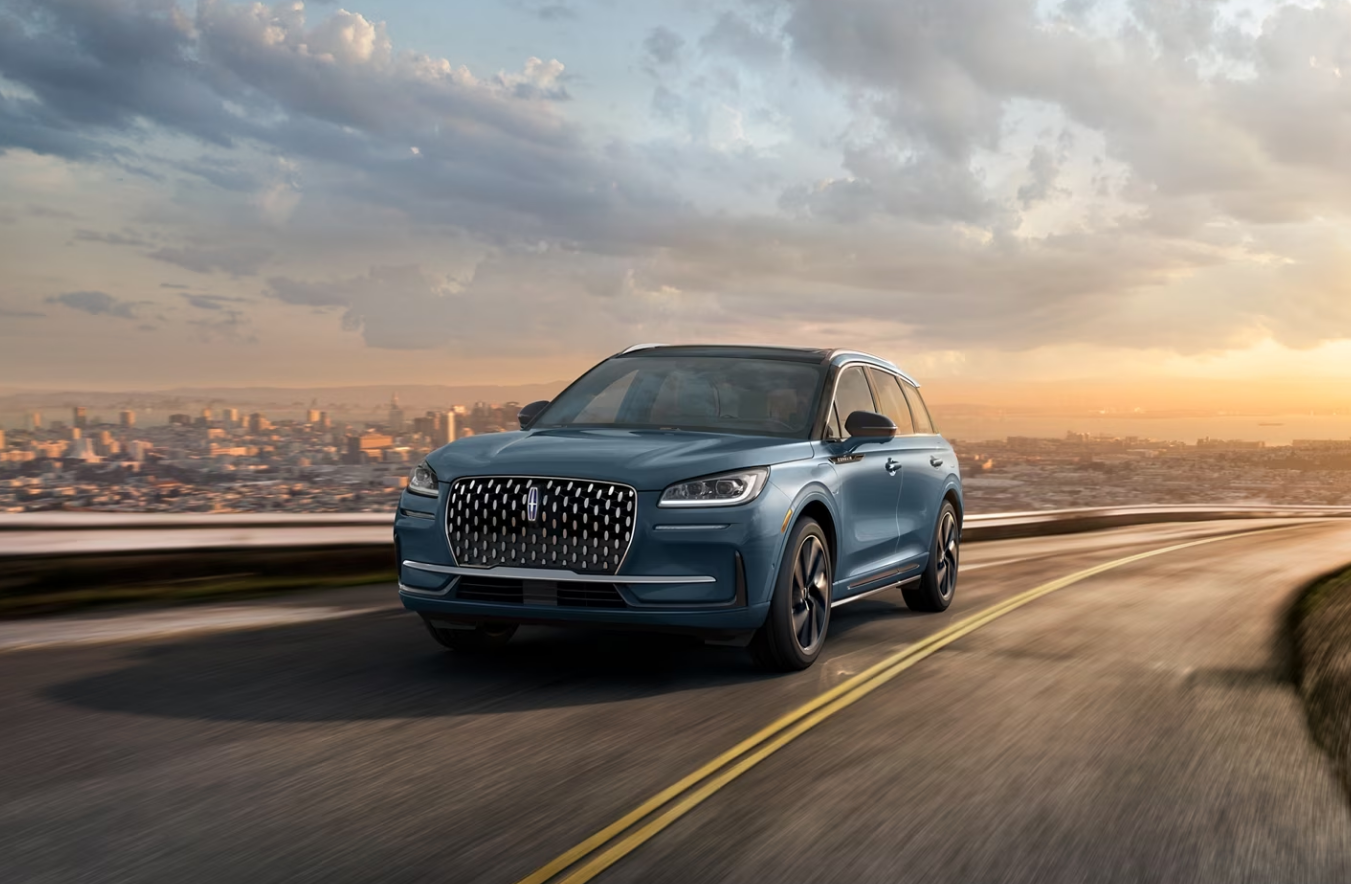
Table of Contents
The 2023 Lincoln Corsair has an advanced Adaptive Cruise Control technology that is easy to use. This makes driving even more enjoyable. This state-of-the-art feature gives cars a smooth and smart cruise control function that changes based on traffic. The 2023 Lincoln Corsair’s Adaptive Cruise Control uses advanced sensors and radar technology to keep a set distance between the car in front of it and the one behind it. This is done to improve both safety and ease. This clever system not only changes the speed automatically to meet the traffic, it also stops the car completely if it needs to and starts moving again as soon as the road is clear. The easy-to-use interface and customizable settings make it easy to switch between different driving situations. This gives drivers a greater sense of control and security on the road. The 2023 Lincoln Corsair’s Adaptive Cruise Control creates a new way to drive by combining technology and luxury. It strikes a perfect mix between style and innovation.
HOW DOES ADAPTIVE CRUISE CONTROL WITH STOP-AND-GO WORK
Adaptive cruise control with stop-and-go uses radar and camera sensors to maintain a set gap between your vehicle and the vehicle in front of you while following it to a complete stop. Stop and go can also be set to follow a vehicle directly in front of you and adjust the set speed, while you are at a complete stop.
ADAPTIVE CRUISE CONTROL PRECAUTIONS
WARNING: You are responsible for controlling your vehicle at all times. The system is designed to be an aid and does not relieve you of your responsibility to drive with due care and attention. Failure to follow this instruction could result in the loss of control of your vehicle, personal injury, or death.
WARNING: Do not use adaptive cruise control on winding roads, in heavy traffic, or when the road surface is slippery. This could result in loss of vehicle control, serious injury, or death.
WARNING: Pay close attention to changing road conditions such as entering or leaving a highway, on roads with intersections or roundabouts, roads without visible lanes of travel, roads that are unpaved, or steep slopes. Failure to follow this instruction could result in the loss of control of your vehicle, personal injury, or death.
WARNING: The system is not a crash warning or avoidance system.
WARNING: Do not use the system when towing a trailer that has aftermarket electronic trailer brake controls. Failure to follow this instruction could result in the loss of control of your vehicle, personal injury, or death.
WARNING: Do not use tire sizes other than those recommended because this can affect the normal operation of the system. Failure to do so may result in a loss of vehicle control, which could result in serious injury.
WARNING: Do not use the system with a snow plow blade installed.
WARNING: Do not use the system in poor visibility, for example, fog, heavy rain, spray, or snow.
When Following a Vehicle
WARNING: When following a vehicle that is braking, your vehicle does not always decelerate quickly enough to avoid a crash without driver intervention. Apply the brakes when necessary. Failure to follow this instruction could result in personal injury or death.
Hilly Condition Usage
Select a lower gear when the system is active in situations such as prolonged downhill driving on steep slopes, for example in mountainous areas.
ADAPTIVE CRUISE CONTROL LIMITATIONS
Sensor Limitations
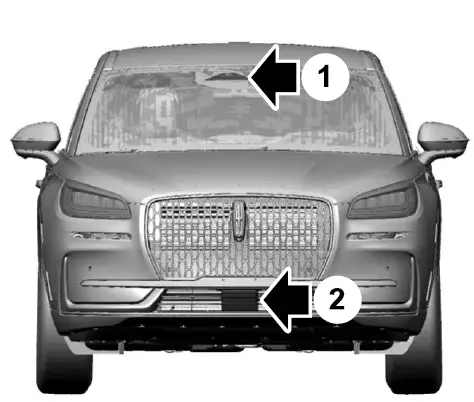
- Radar sensor.
The camera is on the windshield behind the interior mirror.
The radar sensor is in the lower grille. Note: You cannot see the sensor. It is behind a fascia panel. Note: Keep the front of your vehicle free of dirt, metal badges, or objects. Vehicle front protectors, aftermarket lights, additional paint, or plastic coatings could also degrade sensor performance. A message displays if something obstructs the camera or the sensor. When something blocks the sensor, the system cannot detect a vehicle ahead and does not function. See Adaptive Cruise Control – Information Messages. The radar sensor has a limited field of view. It may not detect vehicles at all or detect a vehicle later than expected in some situations. The lead vehicle image does not illuminate if the system does not detect a vehicle in front of you.
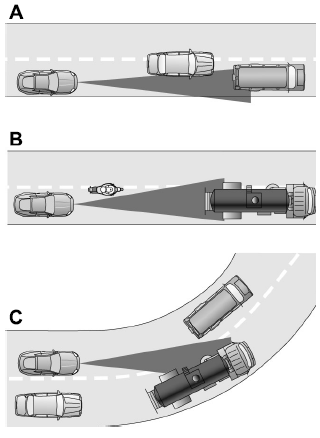
- When driving on a different line than the vehicle in front.
- With vehicles that edge into your lane. The system can only detect these vehicles once they move fully into your lane.
- There may be issues with the detection of vehicles in front when driving into and coming out of a bend or curve in the road.
In these cases, the system may break late or unexpectedly. If something hits the front end of your vehicle or damage occurs, the radar-sensing zone may change. This could cause missed or false vehicle detection. Optimal system performance requires a clear view of the road by the windshield camera. Optimal performance may not occur if:
- The camera is blocked.
- There is poor visibility or lighting conditions.
- There are bad weather conditions.
SWITCHING ADAPTIVE CRUISE CONTROL ON AND OFF

Switching Adaptive Cruise Control Off
Note: When you switch the system off, the set speed clears.
ADAPTIVE CRUISE CONTROL AUTOMATIC CANCELLATION
The system may cancel if:
- The tires lose traction.
- You apply the parking brake.
The system may cancel and set the parking brake if:
- You unbuckle the seatbelt and open the driver door after adaptive cruise control stops your vehicle.
- Adaptive cruise control holds your vehicle at a stop continuously for more than three minutes.
The system may deactivate or prevent activating when requested if:
- The vehicle has a blocked sensor.
- The brake temperature is too high.
- There is a failure in the system or a related system.
SETTING THE ADAPTIVE CRUISE CONTROL SPEED
Drive to the speed you prefer.
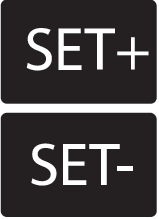
Press either button to set the current speed.
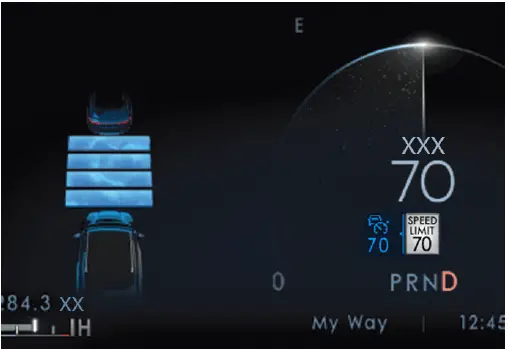
A vehicle image illuminates if there is a vehicle detected in front of you. Note: When adaptive cruise control is active, the speedometer can vary slightly from the set speed displayed in the instrument cluster display.
Setting the Adaptive Cruise Speed from a Complete Stop
Press the SET+ or SET- buttons while keeping the brake pedal fully depressed.
The set speed adjusts to 20 km/h when in metric units or 15 mph when in imperial units. The indicator, current gap setting, and set speed appear in the instrument cluster display. Note: The system activates from a complete stop only when it detects a lead vehicle nearby.
Manually Changing the Set Speed

SETTING THE ADAPTIVE CRUISE CONTROL GAP
You can decrease or increase the distance between your vehicle and the vehicle in front by pressing the gap control.
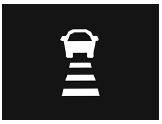
The selected gap appears in the instrument cluster display as shown by the bars in the image. Note: The gap setting is time-dependent and therefore, the distance adjusts with your vehicle speed. Note: It is your responsibility to select a gap appropriate to the driving conditions.
Adaptive Cruise Control Gap Settings
Each time you switch the system on, it selects the last chosen gap setting.
Following a Vehicle
When a vehicle ahead of you enters the same lane or a slower vehicle is ahead in the same lane, the vehicle speed adjusts to maintain the gap setting.
Note: When you are following a vehicle and you switch on a turn signal lamp, adaptive cruise control may provide a small, temporary acceleration to help you pass. Your vehicle maintains a consistent gap from the vehicle ahead until:
- The vehicle in front of you accelerates to a speed above the set speed.
- The vehicle in front of you moves out of the lane you are in.
- You set a new gap distance.
The system applies the brakes to slow down your vehicle to maintain a safe gap distance from the vehicle in front of you. The system only applies limited braking. You can override the system by applying the brakes. Note: The brakes may emit noise when applied by the system. If the system determines that its maximum braking level is not sufficient, an audible warning sounds, a message appears in the instrument cluster display and an indicator flashes when the system continues to brake. Take immediate action.
CANCELING THE SET SPEED

RESUMING THE SET SPEED

Press the button.
The vehicle speed returns to the previously set speed and gap setting. The set speed displays continuously in the instrument cluster display when the system is active. Note: Only use a resume if you are aware of the set speed and intend to return to it.
Resuming the Set Speed from a Complete Stop (If Equipped)
If your vehicle follows a vehicle to a complete stop and remains stationary for less than a few seconds, your vehicle accelerates from a stationary position to follow the vehicle ahead.
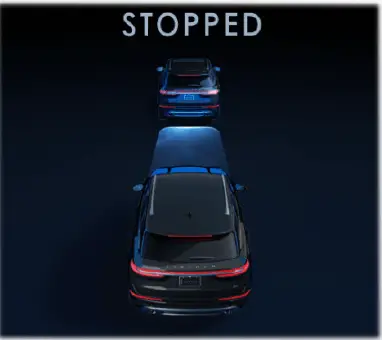
OVERRIDING THE SET SPEED
WARNING: If you override the system by pressing the accelerator pedal, it does not automatically apply the brakes to maintain a gap from any vehicle ahead.
When you press the accelerator pedal, you override the set speed and gap distance. Use the accelerator pedal to intentionally exceed the set speed limit. When you override the system, the indicator remains blue, the set speed is dimmed and the lead vehicle icon does not appear in the instrument cluster display. The system resumes operation when you release the accelerator pedal. The vehicle speed decreases to the set speed, or a lower speed if following a slower vehicle.
ADAPTIVE CRUISE CONTROL INDICATORS
Switching from adaptive cruise control to cruise control.
WARNING: Normal cruise control will not brake when your vehicle is approaching slower vehicles. Always be aware of which mode you have selected and apply the brakes when necessary.
- Press Features on the touchscreen.
- Press Driver Assistance.
- Press Cruise Control.
- Press Normal Cruise Control.
LANE CENTERING
HOW DOES LANE CENTERING WORK Adaptive cruise control with lane centering uses the vehicle’s front radar sensor and front windshield camera sensor, together with the steering sensor to operate. Using these sensors, the system applies continuous steering assistance towards driving in the middle of the lane you choose on highway roads. Note: The gap setting for adaptive cruise control with lane centering, operates in the same way as normal adaptive cruise control.
LANE CENTERING PRECAUTIONS
WARNING: Do not use the system when towing a trailer. Failure to follow this instruction could result in the loss of control of your vehicle, personal injury, or death.
WARNING: Do not use the system if any changes or modifications to the steering wheel have been made. Any changes or modifications to the steering wheel could affect the functionality or performance of the system. Failure to follow this instruction could result in the loss of control of your vehicle, personal injury, or death.
Adaptive cruise control precautions apply to lane centering unless stated otherwise or contradicted by a lane centering precaution. See Adaptive Cruise Control Precautions (page 310).
LANE CENTERING REQUIREMENTS
You must keep your hands on the steering wheel at all times. Lane centering only activates when all of the following occur:
- Adaptive cruise control with lane centering is enabled in your information and entertainment screen. See Switching Lane Centering On and Off.
- You have adaptive cruise control with stop and go enabled and set.
- The steering sensor detects your hands on the steering wheel.
- The system detects both lane markings when driving on a straight road.
- Your vehicle is initially centered in the lane between two visible line markings.
Note: If the system does not detect valid lane line markings, the system will remain on standby until valid line markings are available.
LANE CENTERING LIMITATIONS
Adaptive cruise control limitations apply to lane centering unless stated otherwise or contradicted by a lane centering limitation. See Adaptive Cruise Control Limitations. Lane centering may not correctly operate in any of the following conditions:
- The lane width is too narrow or wide.
- The curve in the road is too small.
- The system does not detect the minimum required lane markings or when lanes merge or split.
- When the required steering effort to maintain lane center exceeds the lane centering system limit.
- When driving in areas that are under construction or when road work is in progress.
- If the front windshield camera and/or the front radar are blocked.
- When using a spare tire.
- Inclement weather conditions include but are not limited to, high wind, heavy rain, and fog.
- Driving into direct sunlight.
- When a modification to the steering system has been made, including alterations to the steering wheel.
- When towing a trailer. See Lane Centering Precautions.
Note: The system steering assistance is limited and may not have sufficient effort for all driving situations and/or conditions, such as driving through tight curves or driving through curves at high speeds. Note: In exceptional conditions, the system may deviate from the lane center.
SWITCHING LANE CENTERING ON AND OFF
You must keep your hands on the steering wheel at all times. The controls are on the steering wheel.

The indicator appears in the instrument cluster. When the lane centering system is on, the color of the indicator changes to indicate the system status. You can override the system at any time by steering your vehicle. Note: The lane-centering requirements must be met before you can enable the feature. See Lane Centering Requirements.
Enabling and Disabling Lane Centering
- Press Adaptive Cruise Control.
- Switch Lane Centering on or off.
LANE CENTERING ALERTS
You must keep your hands on the steering wheel at all times. When the system is active and detects no steering activity for some time, the system alerts you to put your hands on the steering wheel. If you do not react appropriately to the warnings the adaptive cruise control with lane centering system cancels and slows your vehicle down to idle speeds while maintaining steering control. See Lane Centering Automatic Cancellation. The system also alerts you if your vehicle crosses lane line markings without detected steering activity. Note: The system could detect a light grip or light touch on the steering wheel as hands-off driving.
LANE CENTERING AUTOMATIC CANCELLATION
When an external condition cancels the system, for example, no lane line markings available, a tone sounds and a message appears in the instrument cluster display.
- The lane becomes too wide or narrow.
- The system cannot detect valid lane markings.
- Lane markings cross over one another.
- The curve of the road is too sharp.
Note: If your vehicle slows down due to your inactivity twice within a key cycle, the system disables it. To reset the system, when the vehicle is stationary, return the gear selector to park (P) and turn the vehicle off. Then, restart the vehicle with your foot on the brake pedal.
LANE CENTERING MANUAL CANCELLATION
When you perform the following actions, adaptive cruise control with lane centering will cancel:
- The brake pedal is pressed.
- The adaptive cruise control button is switched off on the steering wheel.
The lane centering system is momentarily suppressed when either of the following actions are performed:
- The turn signal indicator is latched or tapped.
- You steer the vehicle out of the lane.
LANE CENTERING INDICATORS
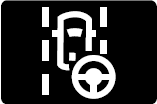
PREDICTIVE SPEED ASSIST
HOW DOES PREDICTIVE SPEED ASSIST WORK Predictive Speed Assist works with adaptive cruise control and adjusts the vehicle speed to the road geometry and the speed limit detected by the speed sign recognition system. As the system identifies curves and highway exits, the vehicle speed temporarily decreases ahead of and during the changing road geometry. When passing new speed signs, the set speed updates. See Predictive Speed Assist Precautions. Some limitations affect the accuracy of the speed sign recognition system and its ability to determine the current speed limit. Predictive speed assist and its ability to determine the current speed limit share these limitations. See Speed Sign Recognition. Note: The adaptive cruise control gap setting operates normally when the feature is enabled.
PREDICTIVE SPEED ASSIST PRECAUTIONS
WARNING: Pay close attention to changing road conditions. You may need to override the system by pressing the brake or accelerator pedal if the adjusted speed becomes higher or lower than necessary.
WARNING: The system only provides limited braking. Your vehicle may not always decelerate quickly enough to avoid a crash without driver intervention. Apply the brakes when necessary.
WARNING: The system does not activate the turn signal.
Adaptive cruise control precautions apply to predictive speed assist unless stated otherwise or contradicted by a predictive speed assist precaution. See Adaptive Cruise Control Precautions. The system only applies limited braking. You can override the system with the accelerator pedal or cancel the system by applying the brakes. The system may adapt to various factors such as time of day, and lane width. This could influence speed adjustments and accelerations. The system may adapt to various drive modes. See Drive Mode Control. This could influence speed adjustments and accelerations. Note: The system does not activate the turn signal automatically.
PREDICTIVE SPEED ASSIST LIMITATIONS
WARNING: The system may not always adjust vehicle speed in certain road or weather conditions such as crossing traffic, yield or stop signs, right of way, traffic lights, speed bumps, rain, snow, and fog. You must always apply the brake or accelerator pedal when necessary.
The road geometry and speed limit information provided by the navigation map data could be inaccurate or out of date. The system may not detect and read speed limit signs with conditional information, for example, when a sign is flashing, during specific time ranges, or when children are present. Note: The system does not set the vehicle speed to speed limits shown with a supplementary traffic sign. Under certain conditions, the system may not adjust the vehicle speed until after your vehicle passes the speed limit. Detection of road geometry operates only where related information is available. Road geometry information may not be available in some areas.
SWITCHING PREDICTIVE SPEED ASSIST MODE ON AND OFF
- Switch Predictive Speed Assist on or off.
ADJUSTING THE SET SPEED TOLERANCE
- Switch Predictive Speed Assist on.
- Press Tolerance.
- Adjust the slider to set the tolerance.
Note: You can set tolerance for vehicle speed adjustment based on speed sign recognition only.
PREDICTIVE SPEED ASSIST ALERTS
If the speed sign recognition system detects a speed limit below the minimum adaptive cruise control set speed, a tone sounds and the system returns to standby mode.
PREDICTIVE SPEED ASSIST INDICATORS
A blue marker around the speed sign and a blue arrow next to the set speed indicate that the system is active.
Speed sign indicator
When the system detects a new speed sign, a gray indicator appears above the set speed while the system adjusts the vehicle speed to the speed limit. When the speed limit is reached, the set speed updates and the gray indicator disappears.
Road geometry indicator
When the system detects a curve or highway exit, the vehicle starts to decelerate, and the indicator appears and changes color.
Road geometry indicator symbols
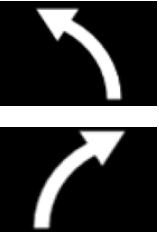
Right curve.
PREDICTIVE SPEED ASSIST – TROUBLESHOOTING
PREDICTIVE SPEED ASSIST – INFORMATION MESSAGES
ADAPTIVE CRUISE CONTROL – TROUBLESHOOTING
ADAPTIVE CRUISE CONTROL –INFORMATION MESSAGES – VEHICLES WITH: LANE CENTERING Note: Depending on your vehicle options and instrument cluster type, some messages can appear different or not at all.
ADAPTIVE CRUISE CONTROL –INFORMATION MESSAGES – VEHICLES WITH: STOP-AND-GO Note: Depending on your vehicle options and instrument cluster type, not all messages display or are available.
Note : The system could abbreviate or shorten certain messages depending on which cluster type you have.
Answer: To activate Adaptive Cruise Control in the 2023 Lincoln Corsair, press the ACC button on the steering wheel and set your desired speed.
Answer: Yes, you can adjust the following distance by using the controls on the steering wheel. Look for the distance setting buttons and choose the desired gap.
Answer: The system will automatically adjust the speed or apply the brakes to maintain the set following distance in response to the cutting-in vehicle.
Answer: You can disengage ACC by pressing the brake pedal or using the cancel button on the steering wheel.
Answer: Yes, the system is designed to work in stop-and-go traffic. It can bring the vehicle to a complete stop and resume when traffic starts moving again.
Answer: Yes, the sensitivity can often be adjusted in the vehicle settings.
Answer: Depending on the model and package, safety features like collision warning, automatic emergency braking, and lane-keeping assist may be integrated with ACC.
Answer: Adaptive Cruise Control in the Lincoln Corsair is typically designed to maintain a set speed but may also adjust speed in curves for safety.
Answer: Yes, there is usually a minimum speed requirement for ACC to engage.
Answer: Yes, you can quickly override ACC by pressing the brake pedal firmly or using the cancel button on the steering wheel.
Answer: Yes, there are typically visual indicators on the instrument cluster or head-up display to show when ACC is active.
Answer: Depending on the vehicle’s features, you may be able to use ACC in conjunction with different driving modes.
Answer: While ACC is designed to work within a certain speed range, there may be limitations at extremely low or high speeds.
Answer: The effectiveness of ACC may be affected by severe weather conditions.
The maximum speed that the Adaptive Cruise Control can maintain is typically adjustable by the driver and is subject to local speed limits.
Useful Link
View Full PDF : 2023 Lincoln Corsair Owner’s Manual | Auto User Guide
2023 Lincoln Corsair Dashboard Warning and Indicator Lights
- Tags 2023 Lincoln , Cruise Control , Lincoln Corsair , User Guide

- Forum Listing
- Advanced Search
- Specific Model Forums
- 1st Gen Forums
How-To: Cruise Control Light (digital cluster)
- Add to quote
Very good. Turned into a sticky.
thats nuts
nice......ill be doing this soon
does the BASIC thing apply the the 94 truck cluster?
couldnt tell ya... i dont have a 2nd gen... does the 2nd gen not have a cruise light either??
is that with the digital cluster or which one is it?
are you talking the 1st gen, or the 2nd gen that FxsX24 brought up?
the 94 cluster has a whole boat load of un used features a/c oil change air bags (may use this one for when i bag it) i believe cruise drl theres a few more i will have to look on my old cluster and find out this is also the analog with tach 94 only
how about this.. low fuel light on a 97? anyone have any experience trying to get it to work btw, i know this is a 1st gen forum but im just wondering..
honestly have no idea dude... i'd have to get a 2nd gen cluster and mess with it... never had one before, and not really willing to spend 40 bucks on one just to mess with it... if i had a 2nd gen, i probably would, though. square body love ftw!
im really sorry, everyone, for the images being down... im trying to find them again... my website went down, and i had the images all linked to it. same happened to my project threads... i am looking through 10,000 pictures trying to find the 5 or so that were taken for this how-to haha
Hey, thanks much, that's neat. Going to try it on my Cameo! I guess i better add the cruise control first.
Has anyone investigated the possibilities of this on a 2nd gen...96 specifically.
does the light not come on when in use on the 96's? i think my 02 does...ill have to check for sure, been a while since ive used it
Not on the 96 or the wifes 02 Blazer2.
I have digital cluster, but I didn't find the cruise light. "Check fluids" is there, but no "Cruise". Does the gauge cluster differ between years or what? Mine is 1992 S-10 Blazer Sport.
i am trying to hookup an aftermarket cruise control but not having much luck. i cannot find which wires or where location is to hookup. help!
So if you had a cluster that didn't have this option and you wanted to put an LED into the dash somewhere would it be as simple as wiring it into the gray wire on the module to make it work?
To answer my own question, this does work. To see mine go here . Only hooking up to the gray wire at the module makes it a "cruise on" light, not a 'cruise actuated' light. Meaning if the crusie is turned on the light is on whether you are using the cruise or not. If I can figure where to get an actuated signal I will report back.
- ?
- 184.1K members
Top Contributors this Month
- Corsair Manuals

Lincoln Corsair: Adaptive Cruise Control / Adaptive Cruise Control Indicators
Vehicles With: Adaptive Cruise Control With Lane Centering
Gray indicates the system is on but inactive.
Green indicates the system is active and applying assistance steering torque input to keep your vehicle in the center of the lane.
Amber with an audible tone and then gray indicates a system auto-cancellation.
Vehicles With: Adaptive Cruise Control With Stop and Go
White indicates the system is on but inactive.
Green indicates that you set the speed and the system is active.
Vehicles With: Intelligent Adaptive Cruise Control
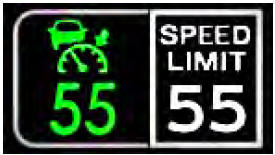
A bracket appears around the set speed and the detected speed limit sign in the information display.
System Warnings
If the set speed is increased beyond the speed limit or speed limit plus a positive tolerance value, the set speed indicator flashes.
The warning does not occur if:
- You override the set speed using the accelerator pedal.
- The vehicle speed exceeds the set speed due to being on a downhill slope.
Canceling the Set Speed. Resuming the Set Speed. Overriding the Set Speed
Switching from adaptive cruise control to cruise control, other information:, lincoln corsair 2020-2024 service manual: removal and installation - front door, lincoln corsair 2020-2024 service manual: removal and installation - rear scuff plate trim panel.
- Manuals Home
- 1st Generation Lincoln Corsair Owners Manual
- 1st Generation Lincoln Corsair Service Manual
- Exterior Mirrors
- Warning Lamps and Indicators
- Programming the Garage Door Opener to Your Hand-Held Transmitter
- New on site
- Most important about car
Selecting a Drive Mode. DRIVE MODES
Selecting a Drive Mode
Note: Drive mode changes may not be available when the ignition is off.
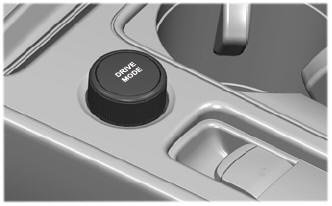

IMAGES
VIDEO
COMMENTS
Most cruise control lights use 2 different colors to let you know what state the system is in. Typically, the cruise control light will be orange when the system is on, but a speed hasn't been chosen yet. Once a speed is selected, this light will turn green. If the computer has detected an issue, this light will stay orange and likely won't ...
Common Cruise Control Symbols and Indicators. Understanding the various symbols and indicators associated with cruise control is important for safe and effective usage. These symbols typically appear on the dashboard (or on the side of the steering wheel) and may include a speedometer icon, "SET," "RES" (resume), and "CANCEL".
In a Subaru, if the gas cap is loose, this can cause the cruise control light to blink. The gas cap helps to maintain the correct pressure in the fuel tank and keeps the fumes inside. If the cap is loose, the check engine light will illuminate and the cruise control light will also flash. If you notice the cruise control light starts flashing ...
This indicator shows the cruise control system status. When cruise control is activated, a green circle will appear to indicate it is set. The vehicle information display will also display the speed the cruise control was set at. If you accelerate past the set speed, the speed will blink until you either cancel cruise control or go back to the ...
Control Switch - If the internal contacts wear out, the cruise control switch may not contact the CCM. This might disable cruise control altogether, or it might not react to the cancel or accelerate functions. Check Engine Light - This is an indicator of a failing engine or fuel pump, which may, in turn, affect acceleration while cruising.. Vacuum Leak - A vacuum leak may affect the ...
Cruise Control Indicator Light. Usually, the cruise control light is not a warning light like many of the others on this list. Instead, it simply reminds you that your cruise control feature is engaged and that you can simply set your car to maintain a constant speed. However, in some cases, if the light isn't green, it can indicate a problem ...
Cruise Control Indicator: Indicates that the Cruise Control is on. Cruise Control is a feature designed to maintain a set speed on the open road, without requiring the driver to hold down the accelerator pedal. The control stalk has a master ON/OFF switch, a speed SET function, and a +/- function that provides moderate acceleration or coasting ...
Cruise Control Indicator. This will be illuminated when you have cruise control on. Directional indicator. Here are your indicators for signaling left or right turns, or to activate hazard warning lights. They flash when turned on. If the indicators stay on or flash faster than normal then check for a burnt-out bulb. Shift Indicator
The cruise control light will light up orange for one of two reasons; either the system has detected an issue and is alerting you or the cruise control is on but a speed has not been set. When everything is functioning properly, your cruise control light will be orange when you first turn cruise control on. When you set a speed, it will turn green.
When you activate or the cruise control is activated, the car informs you by illuminating the cruise main indicator. Note that it signifies activation but not setting- you will still need to set the speed to get the feature to full functionality. After setting the speed, you can release the accelerator pedal and lean back.
In most cases, the Following Distance Indicator uses a forward-looking camera, radar, or a combination of both to detect the presence of a vehicle in front. If your car is close enough, the system measures the distance between the vehicles and displays a "following time" to let you know when you're 0.5 to 2.5 seconds away from the vehicle ...
Set speed can be adjusted with the + and - buttons. To disable cruise control either press the "Driving Assist Switch ", the cancel button or tap the brakes. The indicator light will turn back to white. I haven't totally figured out all the features of the adaptive cruise mode yet.
The following are warning lights and indicators found in vehicles built by Mitsubishi. Click the link to the right of each one to learn more. How They Are Presented. ... Cruise control indicators -- click for more: Rear cross traffic alert indicator -- click for more: Economy operation indicator -- click for more ...
Common cruise control icon on dashboards specified by ISO-7000-2047, ISO 2575:2010, and ISO 6727. Another icon exists for the more modern adaptive cruise control, but some cars also use the cruise control icon for the speed limiter function, which has no standard icon.. Cruise control (also known as speed control, cruise command, autocruise, or tempomat) is a system that automatically controls ...
My cruise control works fine. But the indicator light doesn't light up when engaged I'm assuming the light is old on on my cluster. Was wondering where I could get a new led or bulb from. Unless it's a different problem. Save Share. Like. Sort by Oldest first Oldest first Newest first Most reactions.
Setting the Adaptive Cruise Speed from a Complete Stop. Press the SET+ or SET- buttons while keeping the brake pedal fully depressed. The set speed adjusts to 20 km/h when in metric units or 15 mph when in imperial units. The indicator, current gap setting, and set speed appear in the instrument cluster display.
1983 - 2012 Ranger & B-Series - Cruise Control Indicator - I had cruise control installed on my 2004 ford ranger by a ford dealer and everything works fine except the indicator light in the dash does not come on when you set the speed. The truck was a year old and they had to replace the steering wheel to do it. I...
cruise control indicator light. I believe you should have a parking brake set indicator. You won't have an indicator for OD on, but you do have one to indicate that you have locked OD out with the shifter button. You should see each of those lights briefly when you first turn the key to the ON position.
First off, its a very simple procedure to do, so start by removing the metal back plate from the cluster. Socket size is 7/32". With the backing removed, find the bottom left light socket hole (the one just above the torx screw), and using an Xacto knife, gently cut where i have.
The color of the indicator changes to indicate the system status. White indicates the system is on but inactive. Green indicates that you set the speed and the system is active. Vehicles With: Intelligent Adaptive Cruise Control. A bracket appears around the set speed and the detected speed limit sign in the information display. System Warnings.